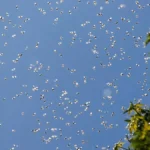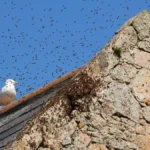Often when bees abscond or swarm from a resting site, we find bees left behind after a swarm. This is a normal part of nature – sad – but normal. Let us have a look at why bees get left behind and what happens to these bees.
We find that in all societies, there is this myth that “no person gets left behind”. Movies like Saving Private Ryan and so on all perpetuate this myth that life is valuable and that somebody cares about you. Life is in fact ruthless, and the only person that really cares about you is you, your dogs, and your parents.
Bees are a society, and when they swarm, they make a decision that is for the benefit of the collective – and as always happens with collective decision making, there are always some people that get left out. Let us have a look at a few types of situations that can cause bees left behind after a swarm.
A Beehive Swarms and Absconds
Bees can decide that there is something that poses a threat to their hive and can make a decision to abscond. When bees abscond, the entire swarm leaves the hive and flies as far as the queen can fly – this may be twenty yards or a few miles. It just depends on the condition of the hive and queen. A run-down hive that was fielding a small brood nest will have a queen that can fly far. In dry conditions, you will often find bees can end up in this mess unless we feed them.
When bees abscond they often do so in a bit of a tempestuous fashion. In many cases, the day started quite normally, and then for some reason, they decided to leave. The worker bees left behind after a swarm in this situation are those that are out in the field collecting nectar. They will gradually come to find their home is abandoned. These poor abandoned workers will sit in a huddle for a day or two and then normally they go off and join other hives, or just die. It is a bit sad really.

Learn more about: What Time Of Day Do Bees Swarm?
Somebody Migrates A Hive
Bees left behind after a swarm is moved are another common occurrence. When we move bees, there can be various situations that result in a big ball of bees being on the floor near the hive the next day.
I once migrated an apiary of 20 hives out of a Eucalyptus grove during the peak honeyflow. The landowner became irritated with my bees stinging his cow’s udders – it made the milk taste funny – and he told me to remove the bees in 24 hours or he would burn them with gasoline. I loaded the hives and moved them far away. The next day this guy was on the phone shouting about how I left half my bees behind. I went back and found a big ball of workers covered in pollen in the middle of the apiary site. It appears that bees actually sleep on Eucalyptus trees at night and then fly back in the mornings. This has been reported by other beekeepers in the area too.
If you move bees during the day there will also be bees left behind after a swarm. Often you can just leave a single empty box in the middle of the apiary site and come back a day later in the evening. You will be able to fetch a few pounds of bees – cover them in sugar and dump them in a weak hive. They have pollen and nectar so they should not be rejected.
A Swarm Gets Over Excited and Leaves Before The Scouts and Workers Are All Back
Sometimes if a swarm is moving towards a very strong honey flow, you will find that the bees will land on a tree or a bush. They will then send scouts out the next morning to look for nesting sites, and sometimes they find such a good site so fast (eg. a beekeepers catch box baited with lemongrass oil) that they leave before all the scouts are back. You will then find bees left behind after a swarm leaves. This is again sad, but you often find these bees sort of vanish after a day or two – they just go and join other hives.
What Happens To Abandoned Bees?
Different races of bees have differing levels of creativity with regard to finding a hive to live in. Apis mellifera capensis is a particularly weird little bee and has a propensity to drift. I have found with these bees that any bees left behind after a swarm will rapidly find other hives to go and join.
I have seen that with other races of bees, the ability of other hives to accept bees is a bit less. With Apis mellifera scutellata as an example, drifting bees from other hives and bees that try to join a hive when they get lost will often be killed. With various races of European bees, the defensiveness of hives varies. I have found Italian bees to be quite accepting of drifting bees whereas Russian bees are a bit less accepting. In this regard, when it comes to bees left behind after a swarm being able to find a new home, we tend to find certain races have a better outcome for lost bees.
I hope this article has helped you understand what happens to bees left behind after a swarm. Nature is brutal, and as much as we like to think of bees as being a perfect society, they are just are flawed as we are. Nobody is indispensable. If you enjoyed this please share.
Read more about: When Do Bees Go Away?
FAQs
[rank_math_rich_snippet id=”s-22aaf58b-a661-4fc2-ab6a-50a373cc489b”]

Dr. Garth A. Cambray is a Canadian/South African entrepreneur and beekeeper with 28 years of experience in apiculture and specializes in adding value to honey. His Ph.D. research developed a new advanced continuous fermentation method for making mead that has resulted in a number of companies globally being able to access markets for mead. His company, Makana Meadery, exports honey mead to the USA where it is available to discerning connoisseurs. He has also developed technologies to commercially manufacture organic honey vinegar in Zambia for export globally. He holds a few patents globally in the ethanol industry and believes in technology and knowledge transfer for human development and environmental sustainability. One of his proudest achievements is the fact that the wind farm he started at one of his old apiary sites has essentially made his hometown carbon neutral.






